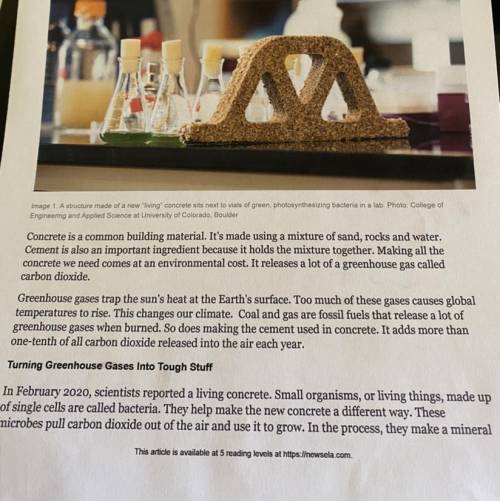
Complete of the article
that helps toughen the new concrete, notes wil Srubar. He is a scientist at the University of
Colorado Boulder. He's also part of the team that developed the concrete.
His team mixed the microbes together with sand. They also added a protein found in bones called
gelatin. Then, they added nutrients that help the bacteria grow. The scientists chose to add
cyanobacteria to their concrete. Cyanobacteria are like the bacteria or green algae that grow in a
fish tank. These bacteria can perform photosynthesis. It is a process that uses carbon dioxide and
light to make food.
The process does not release carbon dioxide, unlike cement. It even stores carbon in the living
cement
The bacteria also make a mineral called calcium carbonate. It is an important ingredient in
cement. Those bits make the new concrete tougher once it is cooled. Cooling the mixture also
makes the gelatin harden. It's just like cooling a jiggly gelatin dessert.
Imagine Living LEGOs, But With Flaws
What if the bacteria survived in the hardening concrete? Srubar's team thought the bacteria might
help make material for new bricks, too. To test the idea, they split a block and melted its pieces.
They added more nutrients to the mix. The bacteria grew. Then, they added sand. They had
enough bacteria and material to build two new concrete blocks. The team split and grew the
material until they made eight bricks from the original block.
But this new approach won't put an end to regular
concrete just yet. Srubar's group works in a lab where
contamination is easy to avoid. In the real world,
other microbes might get into the mix. Other
microbes could take over if they grow faster than the
cyanobacteria. Those other microbes might prove
harmful. Or they might change how the concrete
behaves
Cyanobacteria also need certain things to stay alive.
They won't survive well where it's dry. The living
concrete may only work in places that are warm and humid all year.
Scientists are excited even if it takes a while. There are lots of ways living materials might be used
in the world. "Nature has figured out a lot of really cool things that we can use in our day-to-day
lives," Srubar says. "We just have to pay a little more attention."


Answers: 1
Another question on English

English, 21.06.2019 13:30
In "the fish," elizabeth bishop uses simile and metaphor to develop tone. select one simile and one metaphor from the poem, and explain how each example contributes to the tone of the text. be sure to use specific examples from the text in your response.
Answers: 3

English, 21.06.2019 14:30
Which historical detail can best clarify a reader’s understanding of the information in the excerpt? immigrant factory workers who spoke the same language were separated from each other at work. immigrant factory workers who spoke the same language were known to talk too much at work. immigrant factory workers had to pay rent for their chairs and the supplies they needed at work. immigrant factory workers were crowded into unsafe buildings with locked doors and fire escapes.
Answers: 2

English, 21.06.2019 21:30
In figure 4 of the telephone components what do the labels lettered a to e
Answers: 1

English, 22.06.2019 00:30
"the children's hour" by henry wadsworth longfellow between the dark and the daylight, when the night is beginning to lower, comes a pause in the day's occupations, that is known as the children's hour. i hear in the chamber above me the patter of little feet, the sound of a door that is opened, and voices soft and sweet. from my study i see in the lamplight, descending the broad hall stair, grave alice, and laughing allegra, and edith with golden hair. a whisper, and then a silence: yet i know by their merry eyes they are plotting and planning together to take me by surprise. a sudden rush from the stairway, a sudden raid from the hall! by three doors left unguarded they enter my castle wall! they climb up into my turret o'er the arms and back of my chair; if i try to escape, they surround me; they seem to be everywhere. they almost devour me with kisses, their arms about me entwine, till i think of the bishop of bingen in his mouse-tower on the rhine! do you think, o blue-eyed banditti, because you have scaled the wall, such an old mustache as i am is not a match for you all! i have you fast in my fortress, and will not let you depart, but put you down into the dungeon in the round-tower of my heart. and there will i keep you forever, yes, forever and a day, till the walls shall crumble to ruin, and moulder in dust away! which literary device does longfellow use most frequently in the poem? a. simile b. metaphor c. repetition d. personification
Answers: 2
You know the right answer?
Complete of the article
that helps toughen the new concrete, notes wil Srubar. He is a scientist at...
Questions

World Languages, 29.01.2021 01:20

Mathematics, 29.01.2021 01:20


Mathematics, 29.01.2021 01:20

Mathematics, 29.01.2021 01:20

Biology, 29.01.2021 01:20


Mathematics, 29.01.2021 01:20



Computers and Technology, 29.01.2021 01:20


Mathematics, 29.01.2021 01:20

Chemistry, 29.01.2021 01:20


Biology, 29.01.2021 01:20


Biology, 29.01.2021 01:20




